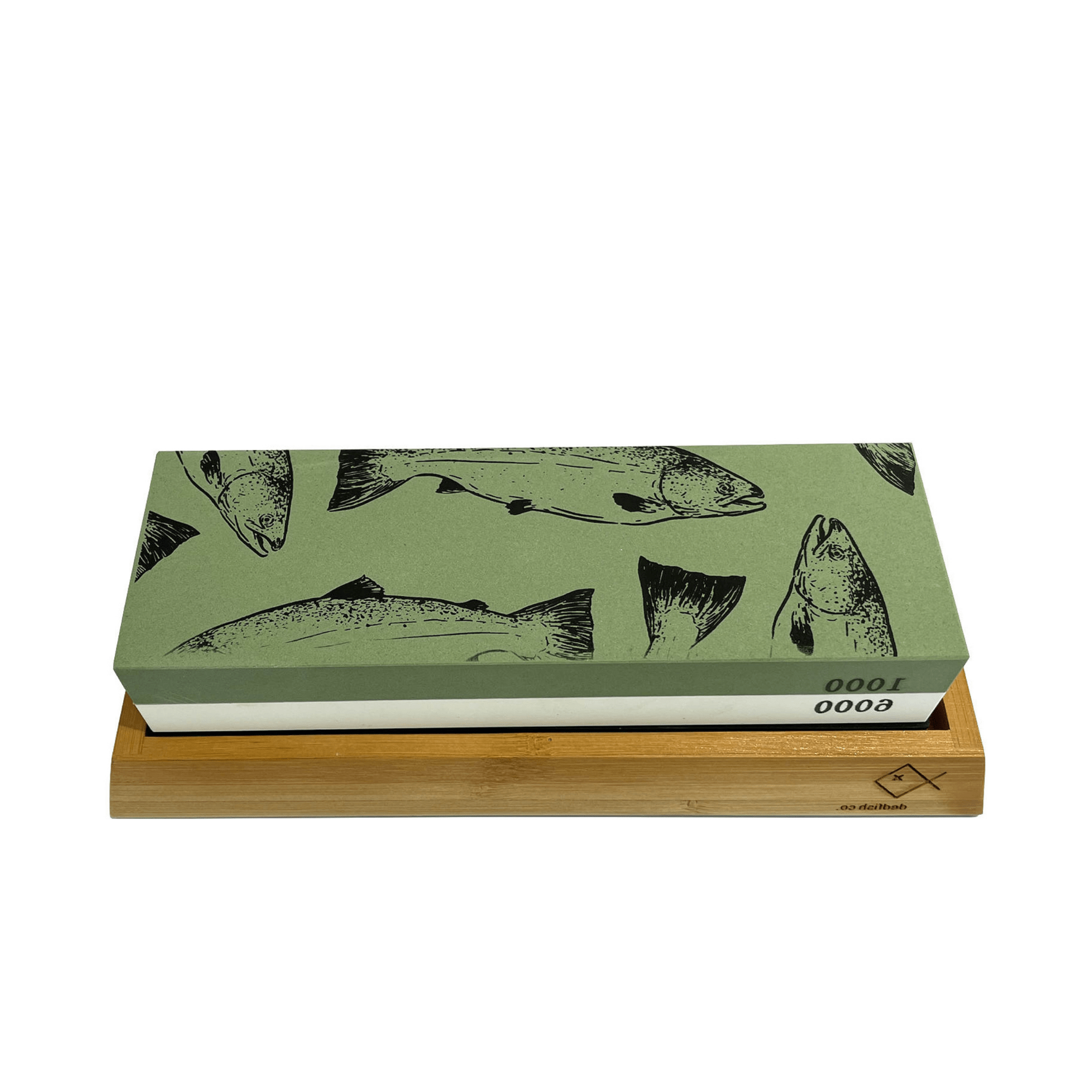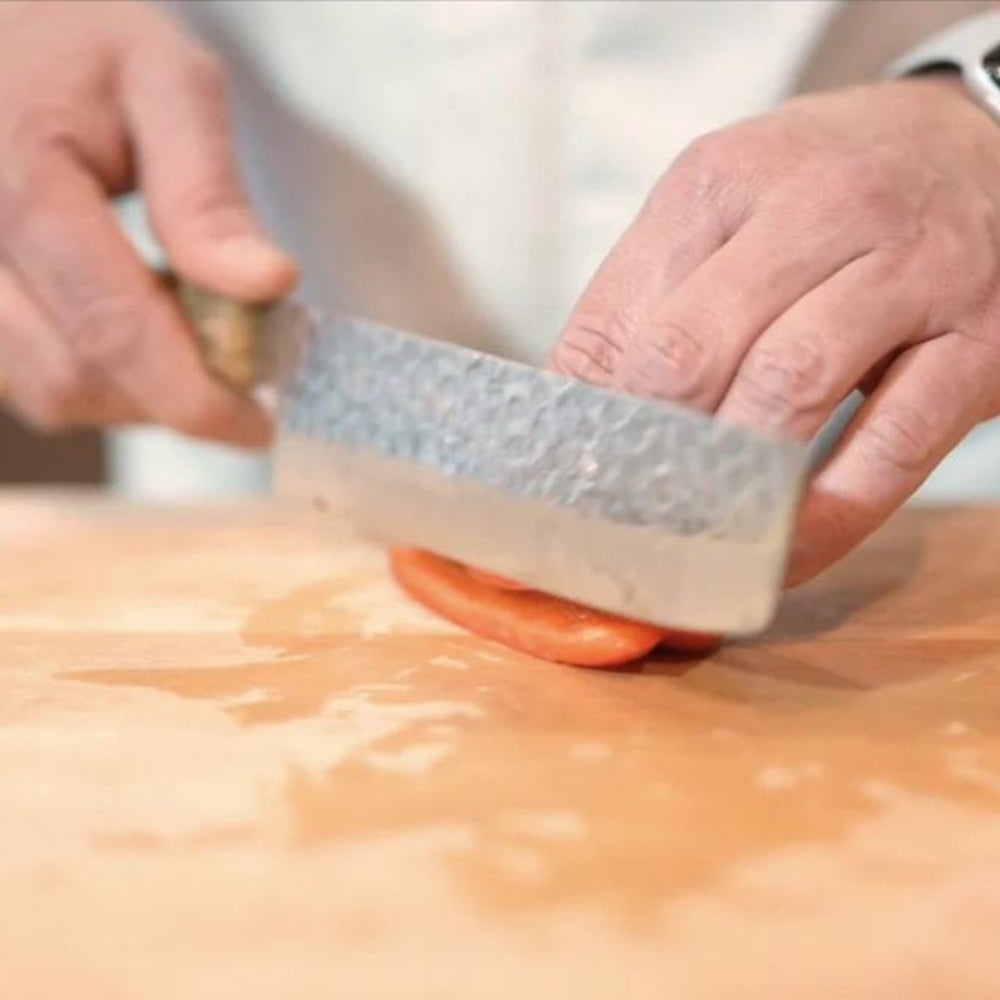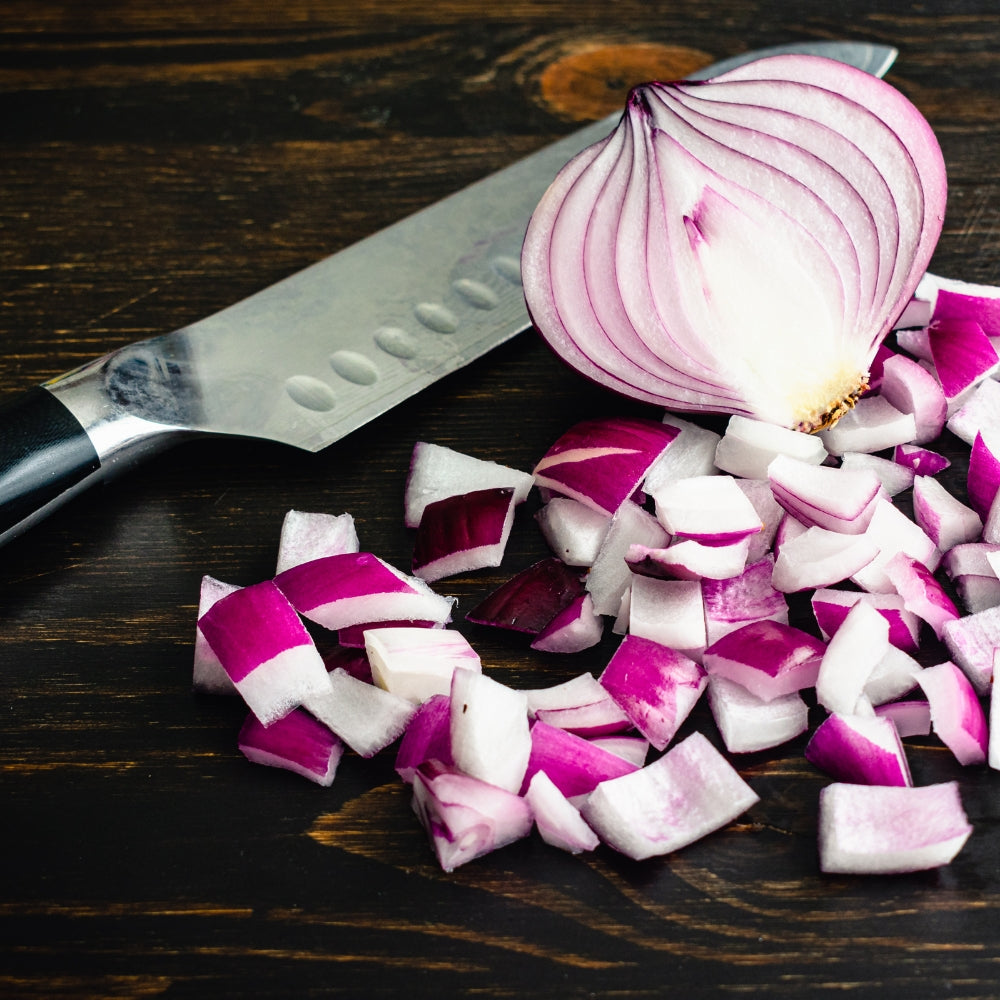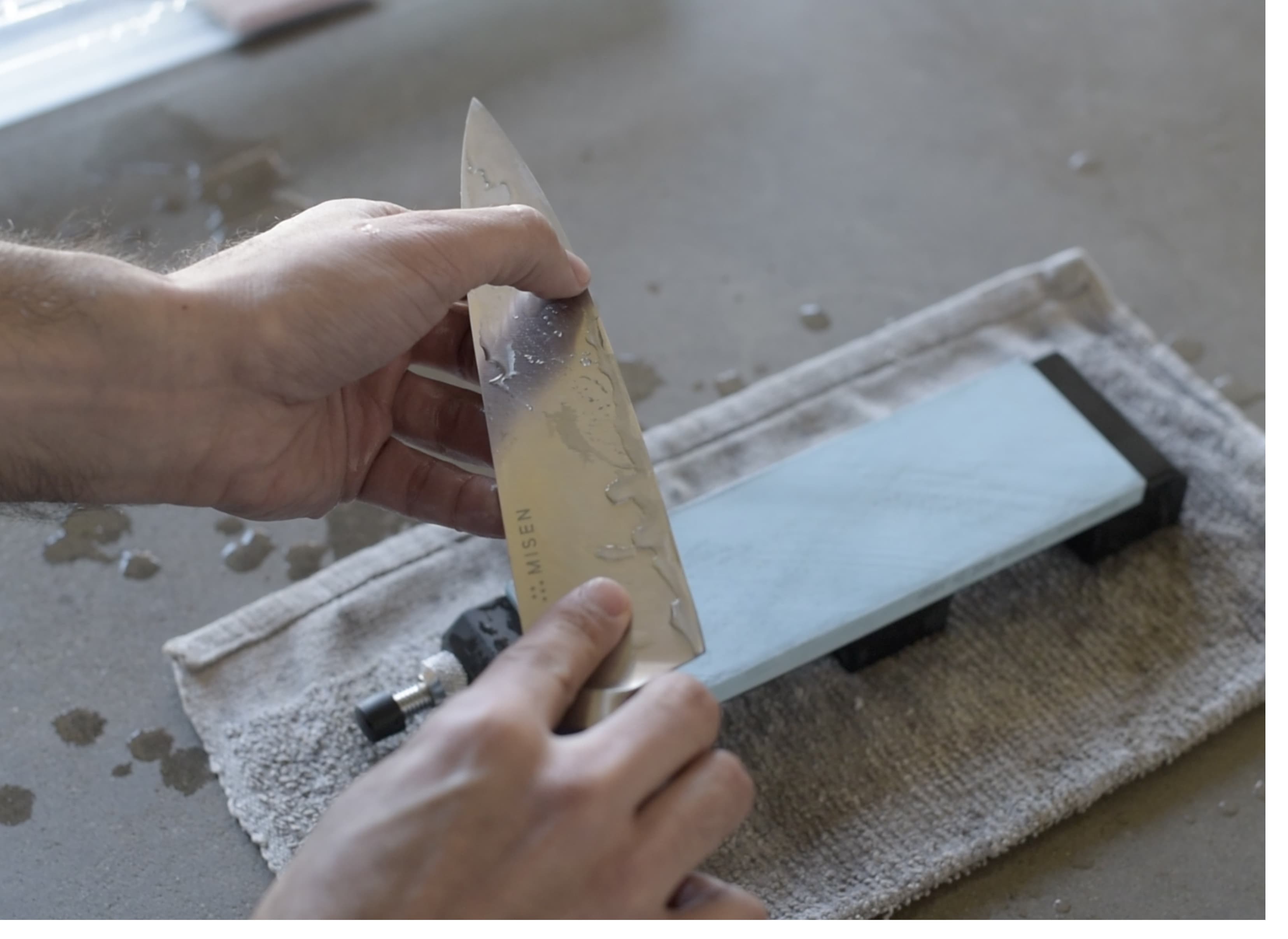
Choosing the Right Whetstone Grit for Your Kitchen Knives
By Kenny Trusnik
Senior Food Writer at Pro Home Cooks
Have you ever wondered what grit whetstone for kitchen knives is the best choice? It's a question that often pops up among culinary enthusiasts and professional chefs alike. The answer is not as clear-cut as it may initially appear.
Different types of knives and their respective uses require different levels of sharpness. This directly impacts your decision when choosing a grit size for your whetstone. In essence, selecting the right one can elevate your knife-sharpening game to new heights.
Apart from just knowing what grit whetstone for kitchen knives suits which situation, understanding why certain stones are better suited to specific tasks is crucial too. After all, knowledge is power - especially in the realm of sharpening!
In this foray into the intricacies of knife upkeep, we'll plunge deep into the particulars (allusion intended).
Ready to elevate your culinary game? Dive deeper into our top picks and discover the best in cookware. Explore now!
Table Of Contents:
- Understanding Whetstone Grits
- Different Types of Whetstones
- Choosing the Right Grit for Kitchen Knives
- Choosing the Right Grit for Kitchen Knives
- Coarse Grit Whetstones
- Medium Grit Whetstones
- Choosing the Right Whetstone Grit for Your Kitchen Knives
- Understanding Grit Numbers
- Choosing the Right Grit
- Consider Your Knife Type
- Choosing the Right Whetstone Grit for Your Kitchen Knives
- Understanding Grit Numbers
- Choosing the Right Grit
- Consider Your Skill Level
- Sharpening Techniques and Angles
- FAQs in Relation to What Grit Whetstone for Kitchen Knives
- Conclusion
Understanding Whetstone Grits
The art of knife sharpening with a grit whetstone is often overlooked in home kitchens. The reality, however, is that the grit size on your stone can make or break the sharpness and longevity of your knives. Just like different pans are used for specific cooking tasks, different grit stones have their unique applications when it comes to knife maintenance.
Coarser grit stones, represented by lower numbers on the scale, might seem intimidating at first due to their rough texture. But they're essential for repairing chips or setting new edges on dull blades. They may remove more metal faster but also leave behind slightly rougher edges - something akin to how high-heat cooking can damage non-stick coatings if not handled properly.
In contrast, finer grit stones are comparable to well-loved kitchen tools that improve over time. These higher-numbered options gently polish rather than aggressively reshape blades - much like how carbon steel pans develop a naturally non-stick seasoning through repeated use.
If you're someone who enjoys honing skills and achieving perfection in all aspects of home cooking, then understanding the role of each grit number in your sharpening process will bring immense satisfaction.
Moving forward from here, we'll explore various types of whetstones including oil stones, water stones, and diamond stones - diving deeper into this world just as we would experiment with diverse cookware materials.
Different Types of Whetstones
Oil stones, water stones, and diamond stones are the key players in the realm of whetstones. Each type boasts its own set of unique traits that can cater to a variety of knife sharpening needs.
The Role of Oil Stones
A nod to tradition, oil stones have carved out their place in history as steadfast tools for knife sharpening. Their claim to fame? A robust durability that slows down wear over time.
These medium grit champions maintain their flat surface longer than other contenders on the market, making them ideal for sustained use. However, be prepared - working with oil can get messy and it demands proper disposal post-use.
Water Stones for Knife Sharpening
In contrast with their oily counterparts, water stones swap out lubricating oils for a good old soak before they're ready to roll. This clean-up friendly feature has earned them popularity among cooking enthusiasts far and wide.
If you're looking to reshape or reprofile your kitchen knives quickly and efficiently, then these might just be your go-to. Bear in mind though; frequent flattening is part-and-parcel when dealing with water stone usage due to uneven wearing tendencies compared with oil-based options.
Diamond Stone: A Modern Approach
Moving into modern times, we encounter diamond stone whetstones which incorporate tiny industrial diamonds embedded right onto the surface instead of finishing sand-like abrasive particles typical in traditional versions like finishing stone or medium grit ones.
This clever design ensures not only an efficient removal rate but also extends lifespan since diamonds resist degradation much better over time.
Navigating through these varied types will largely depend on what exactly you require from your knife maintenance routine along with personal preferences thrown into the mix too.
A solid understanding of how each one functions could prove invaluable while selecting the most appropriate tool according to the requirements at hand.
Choosing the Right Grit for Kitchen Knives
Our next section takes this exploration further by focusing on choosing a suitable whetstone grit based on the condition and usage patterns associated with your kitchen knives, so stay tuned.
When it comes to knife sharpening, your choice of whetstone matters. Oil stones offer durability and longevity but can be messy. Water stones are easy to clean and efficient for reshaping knives, though they wear unevenly over time. Diamond stone whetstones provide a modern approach with their embedded diamonds ensuring efficiency and extended lifespan. The best pick depends on your
Choosing the Right Grit for Kitchen Knives
To maintain your kitchen knives in optimal condition, it's essential to understand the appropriate whetstone grit selection for their current state and use. The key lies in understanding the right whetstone grit selection based on their state and usage. It's not complicated; just be aware of what to watch for.
Determining Knife Condition
First off, take a good look at your knife blade. If it has seen better days with visible dents or rough spots along its edge, then you're looking at some serious reshaping using a coarse-grit stone. Don't fret though; even the dullest blades can be brought back to life with a little elbow grease and patience.
But if your knife is already sporting an enviable sharp edge that just needs minor tweaks here and there - congratulations. You only need finer stones to maintain its cutting prowess.
Matching Usage with Grit Level
Your chopping habits also play into this equation of choosing grit levels. Regularly hacking away at meat slabs or tough veggies like carrots calls for more frequent sharpening sessions using medium-to-fine stones. After all, these tasks demand sharper edges than softer fruits where smooth cuts matter more than precision slices.
Coarse Grit Whetstones
Sharpening knives requires a variety of tools and techniques, yet none is as essential as the coarse stone with its grit number below 1000. However, nothing is quite as important as the coarse stone. With a grit number below 1000, it's an essential tool in every chef's arsenal.
The Role of Coarse Stones in Reshaping Dull Blades
A dull blade isn't just inefficient, it can also be dangerous. The lack of sharpness increases the risk of slipping while preparing food, leading to potential injuries. This is where coarse stones come in.
Designed specifically for reshaping edges when knives have lost their sharpness or sustained damage, these whetstones are highly effective at grinding down metal and restoring your blade to its optimal condition.
Restoring Damaged Edges with Coarse Stone
Kitchen accidents happen, we've all been there. Maybe your favorite knife slipped from your hand and hit the floor or accidentally struck a hard bone while cutting meats, these incidents can cause significant damage to your blade's edge. But don't worry, the coarse stone is here to help.
This type of whetstone excels at restoring heavily damaged edges because it can remove more material than finer grit stones. It's the perfect tool for quickly repairing chips or other extensive damages on your beloved kitchen knives efficiently and effectively.
Medium Grit Whetstones
As we move from reshaping dull blades with coarse stones to maintaining consistent sharpness over time with medium-grit whetstones, which we'll discuss next, it's important to understand that each tool has unique properties that make them suitable for different stages of knife care.
Medium Grit Whetstones
Your culinary journey is a blend of skill, creativity, and the right tools. Among these tools, a medium-grit whetstone plays an essential role in maintaining the sharpness of your kitchen knives. This grit range, from 1000 to 3000, is ideal for general sharpening tasks.
Maintaining Sharpness Over Time
The dance between knife and cutting board becomes clumsy when the blade loses its edge. Enter medium-grit whetstones, a maestro that orchestrates harmony by restoring the finesse of your blades over time.
A well-selected medium grit stone not only sustains sharpness but also rectifies minor imperfections on the blade surface without drastically altering its structure. It's like having your very own sous-chef dedicated to ensuring every slice you make is effortless.
Selecting Your Medium-Grit Stone
Finding a suitable medium grit stone involves considering factors such as knife steel type and hardness level, among others, it's akin to choosing ingredients for a perfect dish. Each stone performs differently based on grain size: smaller grains (higher numbers) lean towards polishing, while larger ones (lower numbers) are more aggressive cutters.
If you're seeking to maintain an already fairly sharp knife without significant changes in edge geometry or new bevel creation, a selection within this range will do wonders.
Ready for another step toward achieving razor-sharp edges? Let's delve into Fine Grit Whetstones next.
Choosing the Right Whetstone Grit for Your Kitchen Knives
Deciding which whetstone grit to go with can be perplexing due to the abundance of choices. The grit of a whetstone refers to the coarseness of its abrasive surface. Different grits are suitable for different stages of sharpening, so it's important to understand the options.
Understanding Grit Numbers
Coarser grits, such as 200 to 1000, are ideal for repairing damaged or dull blades. Finer grits, such as 3000 to 8000, are used for refining and polishing the edge to achieve a razor-sharp finish.
Choosing the Right Grit
If your knives are very dull or have nicks and chips, start with a coarse grit, such as 200 to 400, to remove the imperfections and reshape the edge. Once you have achieved the desired shape, move on to a medium grit, around 1000 to 3000, to refine the edge and remove any remaining scratches.
If your knives are already in decent shape but need a touch-up, a medium to fine grit, such as 3000 to 6000, will be sufficient. This grit range is also suitable for regular maintenance to keep your knives sharp. For those who want an exceptionally sharp edge, a fine to ultra-fine grit, such as 6000 to 8000, will provide a polished finish that glides effortlessly through food.
Consider Your Knife Type
It's important to consider the type of knife you are sharpening when choosing the grit. Softer steel knives, such as those found in most kitchen knives, benefit
Sharpening your kitchen knives is a game of grits. Understanding the range, from 200 for coarse repairs to 8000 for fine polishing, helps you pick the right whetstone. Start with coarser grits for dull or damaged blades and move on to finer ones as needed. Remember - knife type matters too.
Choosing the Right Whetstone Grit for Your Kitchen Knives
Confusion can arise when selecting the correct whetstone grit for kitchen knives. The grit of a whetstone refers to the coarseness of its abrasive surface. Different grits are suitable for different stages of sharpening, so it's important to understand the options.
Understanding Grit Numbers
Coarser grits, such as 200 to 1000, are ideal for repairing damaged or dull blades. Finer grits, such as 3000 to 8000, are used for refining and polishing the edge to achieve a razor-sharp finish.
Choosing the Right Grit
If your knives are very dull or have nicks and chips, start with a coarse grit, such as 200 to 400, to remove the imperfections and reshape the edge. Once you have achieved the desired shape, move on to a medium grit, around 1000 to 3000, to refine the edge and remove any remaining scratches.
If your knives are already in decent shape but need a touch-up, a medium to fine grit, such as 3000 to 6000, will be sufficient. This grit range will help you maintain the sharpness of your knives without removing too much material. For those who want an exceptionally sharp edge, a fine to ultra-fine grit, such as 6000 to 8000, will provide a polished finish that glides effortlessly through food.
Consider Your Skill Level
Coarser grits are more forgiving and easier to use for beginners
Keeping your kitchen knives in top shape requires the right whetstone grit. For damaged or dull blades, coarser grits (200-1000) work best. If you're just refining and polishing an already decent edge, opt for finer grits (3000-8000). Remember to consider your skill level - beginners may find coarser grits easier
Sharpening Techniques and Angles
We're about to delve into the world of knife sharpening angles, a critical component in mastering your kitchen blades. The best sharpening angle isn't universal - it changes based on what you plan to do with your knife. For precision cuts, lower angles take the crown while durability calls for higher angles.
Getting the Angle Right
Achieving that perfect angle during sharpening is no small feat but certainly worth every effort. Imagine working with an edge angled at 15 degrees - such sharpness transforms tasks like vegetable chopping or fish slicing into effortless endeavors. But remember, these finely honed edges demand regular upkeep as they dull rather quickly.
On the other hand, think of using a blade set at around 20-25 degrees. It may not glide through food quite as easily; however, its robustness makes it suitable for heavy-duty jobs like cutting hard vegetables or meat chunks without frequent maintenance requirements.
Selecting Whetstone Grit Size
Moving onto whetstones and their grit sizes - another key factor in achieving desired sharpness levels. Suppose you've got a severely dulled down knife crying out for some TLC; start off with a coarse stone sporting something around 400-grit could be just what you need.
The journey doesn't end there though. Transition next towards medium-range grits (think: 1000-1500). These work wonders smoothing out rough patches left by coarser stones before making way for high-grit stones from 3000 upwards.
FAQs in Relation to What Grit Whetstone for Kitchen Knives
Is a 1000 and 3000 grit whetstone enough?
A 1000 and 3000 grit whetstone duo is sufficient for regular maintenance of kitchen knives, with the former shaping the edge and the latter refining it.
What grit progression for kitchen knives?
The typical progression starts from coarse (below 1000), medium (1000-3000), fine (3000-6000) to ultra-fine (above 6000) depending on your knife's condition and usage.
Is a 2000 grit whetstone enough?
A standalone use of a 2000-grit stone can maintain sharpness but won't be effective in repairing dull or damaged blades. Pairing it with coarser stones would yield better results.
What is a 6000 grit whetstone for?
A stone at this level provides an exceptionally smooth finish, making your blade razor-sharp. It's often used as a finishing touch after using lower-grade stones.
Conclusion
Understanding whetstone grits is the first step to achieving razor-sharp kitchen knives. From coarse to ultra-fine, each grit level has a unique role in the sharpening process.
Different types of stones like oil, water, and diamond also bring their own advantages when it comes to honing your blades.
The condition and usage of your knife are key factors in choosing the right grit whetstone for your kitchen knives. Coarser stones help restore dull or damaged edges, while finer ones maintain sharpness over time.
Medium-grit whetstones offer general sharpening capabilities that keep your tools at peak performance. Fine-grit stones take things up a notch by delivering incredibly smooth, razor-sharp edges on your favorite cutlery.
If precision cuts are required, an ultra-fine stone can elevate the sharpness even further. And remember, getting the angle right during sharpening makes all the difference!
Transform your kitchen experience with the best tools handpicked by Mike. Don't miss out on these essentials. Check out our top selections now!
TOP ARTICLES

Sourdough Baking School
Master the art of sourdough bread baking in the most comprehensive baking class on the internet. This class features over three hours of baking content to help you start your sourdough journey.
See More




